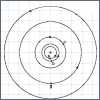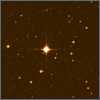Extra Solar Planets
Gliese 581 is a slightly variable type M3V red dwarf about 20.3 light years away from Earth. Its mass and size are both estimated to be about 30% that of the Sun, and it is approximately ten billion years old; about twice as old as our Sun. It appears to have four confirmed planets that are named, following normal astronomical practice Gliese 581b, c, d, e that were found up to 2009. The star and its first three planets are shown under three planet systems in the Visualization in the Introduction. The conjectured discovery of two more planets (Gliese 581f & 581g) was announced in 2010, but as at September, 2013, this remains unconfirmed.
Gliese 581
To the right is a schematic of how the orbits of the planets would look based on current data. For a star like Gliese 581, the habitable zone, or the "goldilocks Zone", stretches from about 0.08 AU to 0.25 AU (approximately 12 to 37 million km or 7 to 24 million miles). Thus, planets 581c and 581d are on the borders of the habitable zone while 581g, if it is confirmed, is right in the middle. The orbits are depicted as circular for simplicity.
A photograph of Gliese 581 taken by the
Digital Sky Survey/ESO.
Digital Sky Survey/ESO.
| Planet | Description (in order from the star; all quoted values are approximate) |
| Gliese 581e | Discovered on 21 April 2009 using the radial velocity technique. It is the smallest confirmed planet discovered so far that orbits a normal star rather than a neutron star, but see also the planet HD 10180b which is unconfirmed, but could be smaller. It weighs at least 1.7 Earth masses, but orbits very close to its primary; just 4.2 million km (2.6 million miles) away, taking just 3.15 days for one orbit. Its surface temperature would be something like 700ºK to 1,000ºK, and it would receive huge amounts of radiation from its primary, so it is not habitable for life as we know it. It is almost certainly a rocky world, rather than a gas giant. |
| Gliese 581b | This planet was discovered in 2005. At a minimum, it weighs about 16 Earth masses, which is similar to the mass of Neptune in our Solar System. It could, however, weigh as much as about 30 times the Earth's mass. It orbits very close to its star being only about six million kilometers (3.75 million miles) away, and completing an orbit every 5.4 days. Of course, being a red dwarf, the star is much less luminous than the sun. Nevertheless, the surface temperature is likely to be around 700 ºK (423ºC), so not very hospitable. |
| Gliese 581c | The mass of Gliese 581c is at least 5.6, but could be as much as 10.2, times that of the Earth, and it was discovered in 2007. If it is around the minimum mass, and its composition is similar to that of the earth, its diameter would be only about 50% more than Earth's. On the other hand, it could just be a small gas giant. It orbits once every 13 days or so at a distance of about 11 million km (6.875 million miles). Estimates of its surface temperature vary enormously depending on what assumptions are made. It could be as low as 0C (32ºF) to 40C (104ºF). However, if it suffers from a runaway greenhouse effect, it could have temperatures similar to Venus; around 750ºK ( 477ºC). |
| Gliese 581g | Gliese 581g is unconfirmed, and studies published in 2011, 2012 and 2013 tend to the view that Gliese 581f, and 581g, do not exist, so the question remains open. The discovery was announced in late September 2010. If it exists, it is located near the middle of the habitable zone at about 22 million km (13.5 million miles). With a mass estimated to be between 3.1 and 4.3 times Earth's, Gliese 581g is considered a super-Earth, and is the planet closest in size to Earth known in a habitable zone. If it is a rocky planet, it is probably about 1.7 to 2 times the diameter of the Earth with gravity at the surface of between 1.1 and 1.7 times the Earth's. This could all result in both liquid water on its surface and an atmosphere. However, recent observations have failed to detect the planet. It may take an additional year or two of observation to clarify the situation. If the discovery is confirmed, it is incredibly important. In a very short period of searching for extra-solar planets, one has already been found that is similar in size to the Earth, and in its habitable zone. Extrapolating these results could mean that the possibility of finding habitable planets is much higher than previously thought. Some astronomers suggest that based on this data, the proportion of stars with habitable planets may be greater than ten percent. |
| Gliese 581d | Because of its mass, between 7 and 14 times that of Earth, the planet is classified as a super-Earth. In late April 2009, new observations by the original discovery team concluded that the planet is within the habitable zone where liquid water may exist. Its orbit is eccentric with its closest approach to Gliese 581 at 21 Million km (13.125 million miles) and its furthest at 49 million km (30.625 million miles). Each orbit takes approximately 66.8 days. While it receives substantially less sunlight than the Earth, the actual temperature on its surface would be influenced by the presence of greenhouse gasses which, if present, could increase the temperature substantially. Michel Mayor, one of the original discoverers, says "We can only speculate at this stage, but it may have a rocky core, encased in an icy layer, with a liquid ocean at the surface and an atmosphere". Alternatively, if it has close to the maximum mass, it could be another Uranus-like planet. |
| Gliese 581f | Gliese 581f remains unconfirmed, and studies published in 2011, 2012 and 2013 tend to the view that Gliese 581f, and 581g, do not exist, so the question remains open. It would have a mass of at least 7 Earth masses, and orbit at a distance of about 113 million km (a little over 70 million miles) once every 433 days. |



